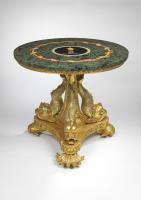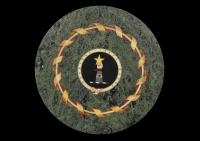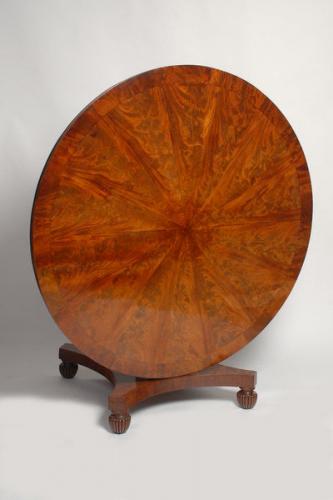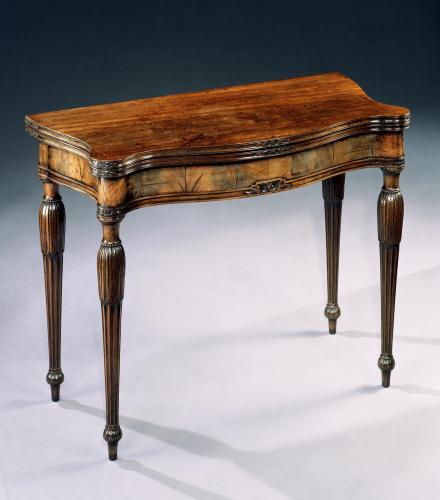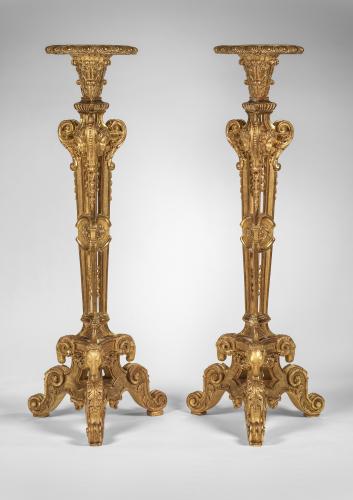
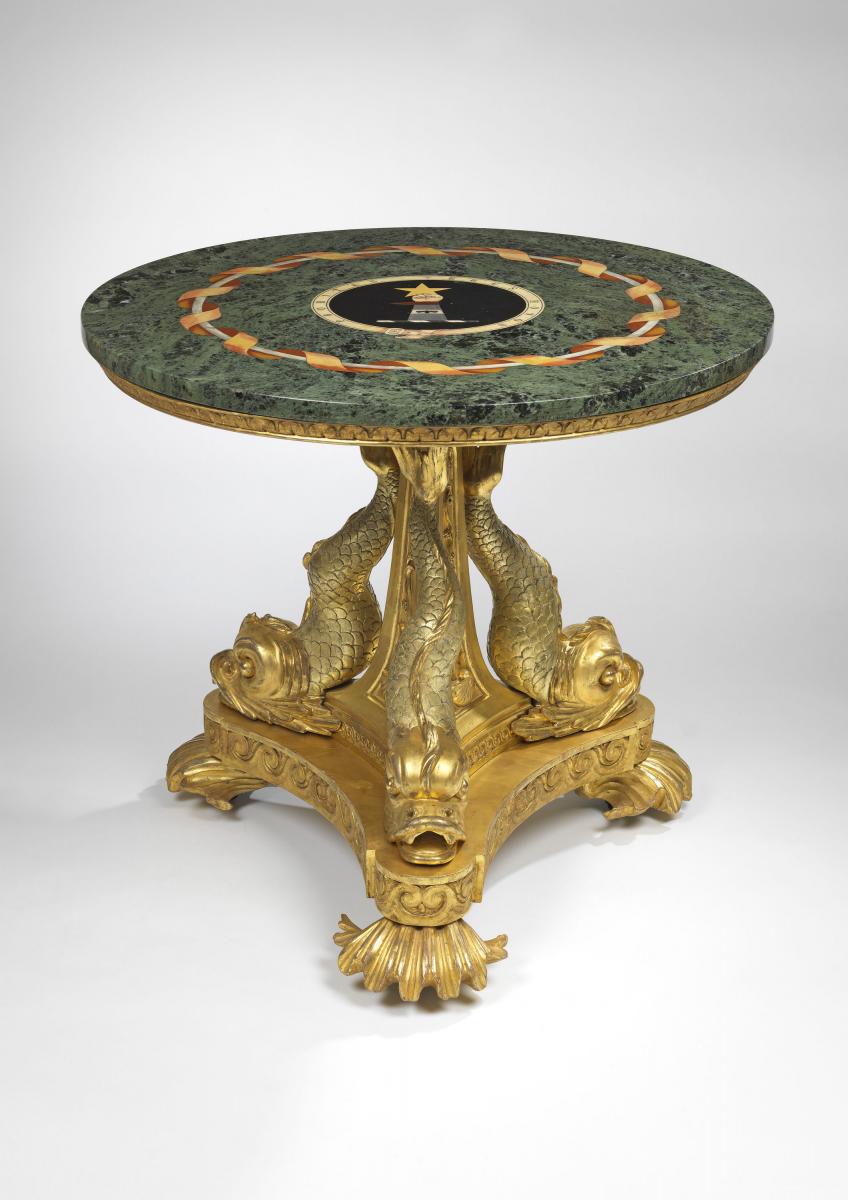
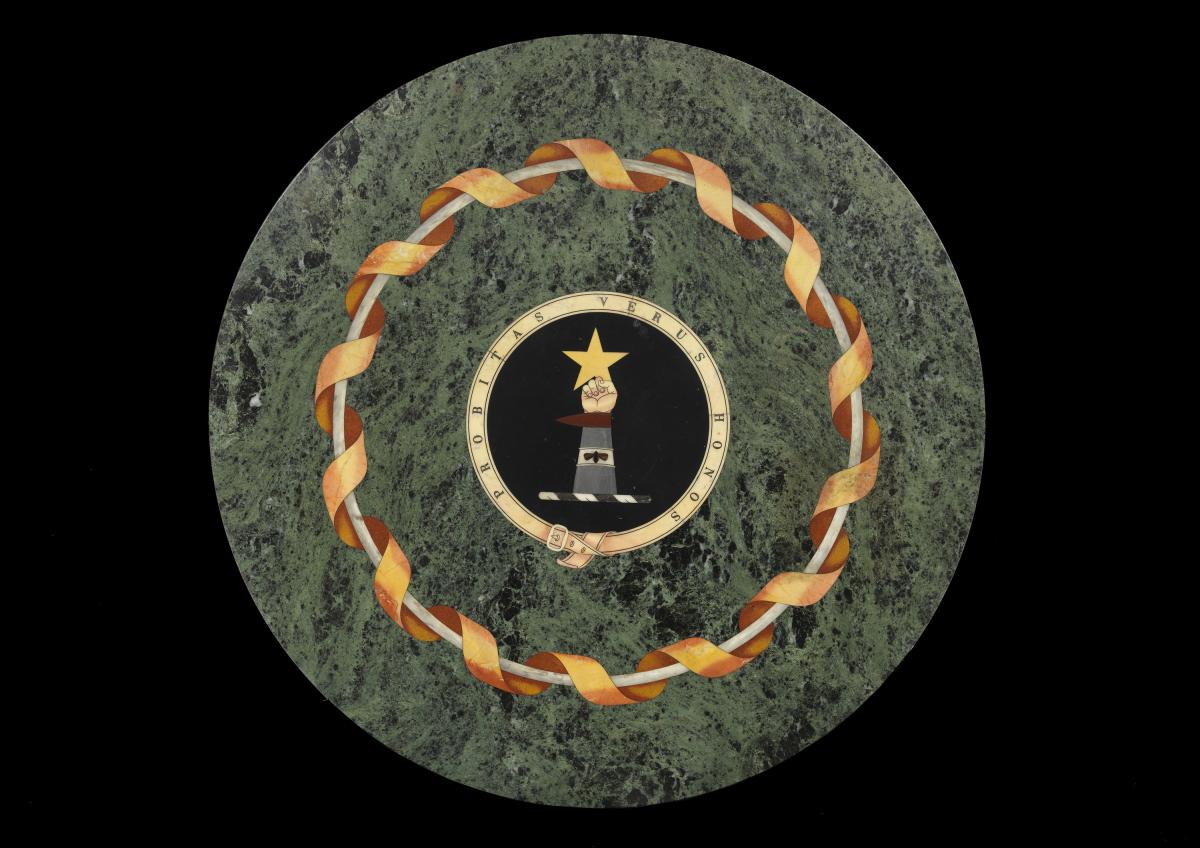
Price on application
This object is eligible for a Certificate of BADA Provenance
The BADA Standard
- Since 1918, BADA has been the leading association for the antiques and fine art trade
- Members are elected for their knowledge, integrity and quality of stock
- Our clients are protected by BADA’s code of conduct
- Our dealers’ membership is reviewed and renewed annually
- Bada.org is a non-profit site: clients deal directly with members and they pay no hidden fees
The circular verde antico marble top with the central crest of the Hansard family holding a five pointed star with a belt border inset with the motto PROBITAS VERUS HONOS, (meaning honesty or integrity is true honour), on a black marble ground within a Rose de Valence riband tied border above a triform shaft, carved with cornucopiae issuing scrolling leaves and flowerheads, flanked by three large dolphin supports on a triangular platform base carved with Vitruvian scrolls and shell carved feet, with castors.
The marble top was very likely ordered from J. Darmanin & Sons of Malta. The firm at the beginning of the 19th Century specialized in Armorial tabletops and the discovery of their paper label on a table in the Victoria and Albert Museum has enabled the attribution of a number of other tabletops.
The skill of inlaying marble was gained in the 17th Century when the Knights of St John decorated the interior of their church with marble tombstones, which were intricately decorated with coats of arms. The Maltese practice of marble mosaic extended into the period of British rule (1800–1964), diversifying into the supply of inlaid marble table tops for secular use.
Provenance:
Probably commissioned by Luke Hansard (1752-1828), printer and founder of Hansards, the parliamentary journals, presumably thence by descent to his son:
James Hansard (1781-1849) and by descent to his son:
Luke James Hansard (1805-1889) and by descent to his son:
Luke Hansard (b.1842) and by descent to his son:
Luke Gerald Hansard (b.1885) and by descent to his daughter:
Audrey Hansard and thence by descent to the vendor.
The Hansard family tree is complex with many of Luke Hansard's descendants having large families and with a continued use of the name 'Luke'. Luke Gerald Hansard (1885) recalled that '...most of the relics' of the printer Luke Hansard descended to Arddyn de Lembeke (née Hansard, b.1891), Luke Hansard's great great granddaughter through his elder son, Luke Graves Hansard (1783-1841).
Arddyn inherited the estates of her parents in 1927, having lost her father, mother and brother all within the year. Arddyn and her Peruvian husband were by the 1920s living in America and it is possible that at this point further Hansard heirlooms were dispersed amongst family members. The Hansard family presented the portrait of Luke Hansard by Samuel Lane to The House of Commons in 1942.
Luke Hansard was the Norwich born printer who gave his name to Hansard and the record of debates in Parliament which his firm printed. Hansard completed his apprenticeship in Norwich and came to London and began working as a compositor in the office of John Hughs (1703-1771), who was printer to the House of Commons.
Hansard was to become a partner in the firm in 1774 and by 1780 had taken control of the business, taking ownership in 1800. Hansard was praised as the most accurate printer of Greek and moved in esteemed circles, counting Robert Orme, Burke and Dr Johnson amongst his friends. He was eventually to be joined in the business by several of his sons and the business became known as Luke Hansard & Sons and operated from premises in Parker Street, off Drury Lane.
It was the union with Ireland in 1801, and the increase in parliamentary printing that this generated, that was to necessitate Hansard giving up most of his private printing work, and he devised numerous expedients for reducing the expense of publishing the parliamentary reports. The company was to become known as the Hansard Publishing Union. Luke's son, Thomas Curson Hansard, was to take over the firm in 1809 and the publication was referred to as 'Hansard' from 1829.
Hansard was granted the crest and coat of arms that appear on the pietre dure top on 17 November 1809. The description of the crest does differ slightly from the description in the grant, in that the cuff of the sleeve in the grant is yellow, while it is red on the table top and it has been suggested, considering the language of the grant, that Luke Hansard may have been using the crest prior to the grant.
The granting of the crest and arms coincides with the date of Luke Hansard standing down and letting his son, Thomas, take the reins of the family business.
Dimensions
34.5 x 30.5 high (88 x 78cm)The BADA Standard
- Since 1918, BADA has been the leading association for the antiques and fine art trade
- Members are elected for their knowledge, integrity and quality of stock
- Our clients are protected by BADA’s code of conduct
- Our dealers’ membership is reviewed and renewed annually
- Bada.org is a non-profit site: clients deal directly with members and they pay no hidden fees


